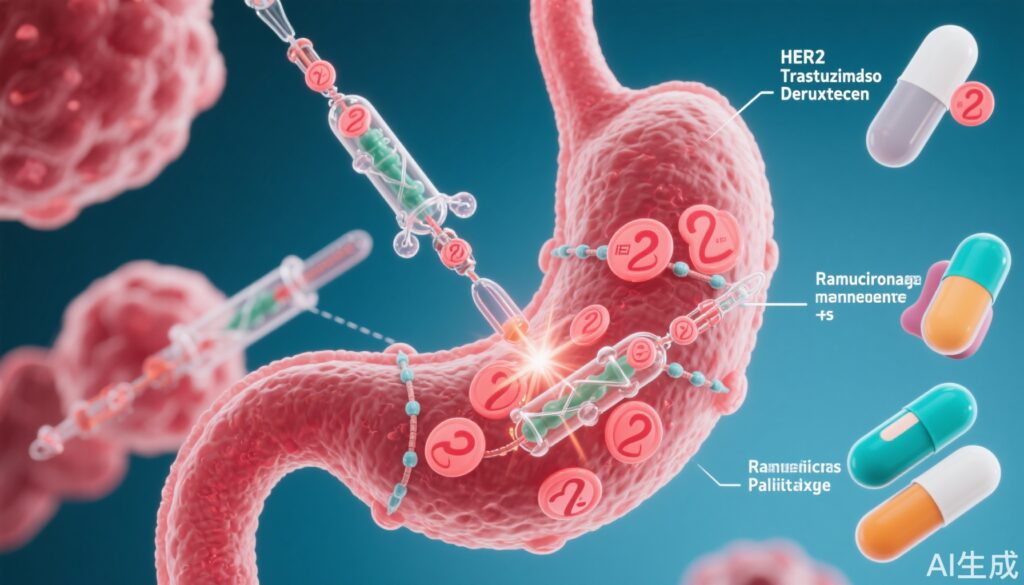Highlight
Recent phase 3 evidence demonstrates that trastuzumab deruxtecan significantly prolongs overall survival compared to ramucirumab plus paclitaxel in patients with HER2-positive metastatic gastric or gastroesophageal junction adenocarcinoma after progression on trastuzumab-based therapy. The safety profile is manageable, with a notable but mostly low-grade risk of interstitial lung disease (ILD) associated with trastuzumab deruxtecan. Complementary real-world data from Japan confirm effectiveness and safety in routine clinical practice.
Clinical Background and Disease Burden
Gastric cancer remains a global health challenge, with metastatic or unresectable disease carrying a poor prognosis. Approximately 15-20% of gastric and gastroesophageal junction (GEJ) adenocarcinomas overexpress human epidermal growth factor receptor 2 (HER2), a biomarker predictive of response to HER2-targeted therapies. First-line treatment typically includes trastuzumab combined with chemotherapy. However, options for second-line therapy after progression are limited, with ramucirumab plus paclitaxel being a standard choice regardless of HER2 status. The emergence of trastuzumab deruxtecan, an antibody-drug conjugate targeting HER2, offers a promising novel treatment paradigm addressing an unmet medical need in this population.
Research Methodology
An international, randomized, phase 3 trial (DESTINY-Gastric04, NCT04704934) enrolled 494 patients with HER2-positive metastatic gastric or GEJ adenocarcinoma confirmed on tumor biopsy after progression on trastuzumab-based therapy. Participants were randomized to receive either trastuzumab deruxtecan at 6.4 mg/kg intravenously or the combination of ramucirumab plus paclitaxel as second-line treatment. The primary endpoint was overall survival (OS). Secondary endpoints included progression-free survival (PFS), confirmed objective response rate (ORR), disease control rate, duration of response, and safety outcomes. In parallel, a Japanese retrospective cohort study (EN-DEAVOR) evaluated real-world effectiveness and safety of trastuzumab deruxtecan in 312 patients with HER2-positive unresectable advanced or recurrent gastric/GEJ adenocarcinoma post-chemotherapy progression, assessing OS, real-world PFS (rwPFS), time to treatment failure (TTF), ORR, and adverse event (AE) profiles.
Key Findings
In the DESTINY-Gastric04 trial, trastuzumab deruxtecan yielded a median OS of 14.7 months compared to 11.4 months with ramucirumab plus paclitaxel (hazard ratio [HR] for death 0.70; 95% confidence interval [CI], 0.55 to 0.90; P=0.004), indicating a 30% reduction in risk of death. Median PFS was also significantly improved (HR for progression or death 0.74; 95% CI, 0.59 to 0.92). The confirmed objective response rate was 44.3% with trastuzumab deruxtecan versus 29.1% with ramucirumab plus paclitaxel, evidencing enhanced tumor control. Drug-related adverse events (AEs) occurred in over 90% of patients in both groups, with grade 3 or higher AEs occurring in 50.0% and 54.1%, respectively. Importantly, adjudicated drug-related interstitial lung disease or pneumonitis occurred in 13.9% of trastuzumab deruxtecan recipients, mostly grade 1 or 2, compared to 1.3% in the ramucirumab plus paclitaxel group.
In the EN-DEAVOR real-world cohort, the median OS was 8.9 months (95% CI, 8.0-11.0), rwPFS 4.6 months (95% CI, 4.0-5.1), and TTF 3.9 months (95% CI, 3.4-4.2). The objective response rate was 42.9% among patients with measurable lesions, aligning closely with clinical trial data. Grade ≥3 adverse events affected 48.4% of patients, with 2.6% experiencing grade 5 events. Dose modifications due to AEs were common but no new safety signals emerged, supporting the tolerability of trastuzumab deruxtecan in routine practice.
Mechanistic Insights
Trastuzumab deruxtecan is an antibody-drug conjugate combining a humanized anti-HER2 antibody with a potent topoisomerase I inhibitor payload via a cleavable linker. This design enables targeted delivery and internalization into HER2-expressing tumor cells, facilitating selective cytotoxicity. The enhanced efficacy over ramucirumab plus paclitaxel, which targets angiogenesis and microtubule dynamics respectively, may be attributable to this direct tumor-targeted mechanism. The observed ILD risk is believed to arise from off-target pulmonary toxicity related to the cytotoxic payload and immune-mediated mechanisms.
Controversies and Limitations
While trastuzumab deruxtecan improves survival, ILD remains a clinically relevant toxicity requiring vigilant monitoring and early intervention. The phase 3 trial enrolled patients with confirmed HER2 positivity post-progression on trastuzumab-based therapy, which may limit generalizability to broader populations. Additionally, median OS in the real-world Japanese cohort was shorter than that reported in the phase 3 trial, possibly reflecting differences in patient characteristics, performance status, or treatment settings. Further studies are needed to optimize patient selection, manage toxicity, and evaluate combination strategies.
Conclusions
Trastuzumab deruxtecan represents a significant therapeutic advancement for patients with HER2-positive metastatic gastric or gastroesophageal junction adenocarcinoma after trastuzumab failure, demonstrating superior overall survival and response rates compared to standard second-line ramucirumab plus paclitaxel. The safety profile, including manageable ILD risk, supports its integration into clinical practice. Real-world evidence corroborates clinical trial results, reinforcing trastuzumab deruxtecan as a valuable option in this high-need patient population.
References
Shitara K, Van Cutsem E, Gümüş M, et al. Trastuzumab Deruxtecan or Ramucirumab plus Paclitaxel in Gastric Cancer. N Engl J Med. 2025;393(4):336-348. doi:10.1056/NEJMoa2503119
Kawakami H, Nakanishi K, Makiyama A, et al. Real-world effectiveness and safety of trastuzumab-deruxtecan in Japanese patients with HER2-positive advanced gastric cancer (EN-DEAVOR study). Gastric Cancer. 2025;28(1):51-61. doi:10.1007/s10120-024-01555-w



